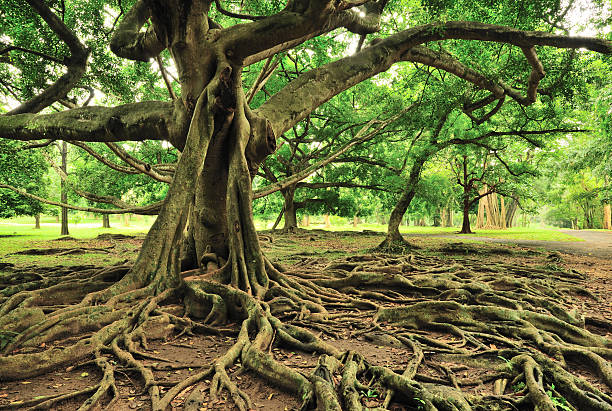The Banyan tree, or Ficus benghalensis, is more than just a majestic symbol of India’s ecological heritage—it’s a natural oxygen factory, spiritual icon, biodiversity hub, and climate warrior. For centuries, this massive tree with its sprawling branches and aerial roots has been at the heart of Indian villages, temple courtyards, and sacred groves. With growing concerns about air pollution and climate change, the banyan tree plantation in India is gaining renewed attention as one of the most sustainable and long-term green solutions.
Why the Banyan Tree Is Called an Oxygen Factory
Among all the oxygen-producing trees, the banyan tree stands out due to its sheer size and surface area. A single banyan can cover acres of land and live for centuries, continuously absorbing carbon dioxide and releasing oxygen, making it a key contributor to cleaner air.
- High leaf density allows more photosynthesis per unit area.
- Aerial roots and large canopy trap dust and purify the air.
- Active in converting CO₂ into oxygen even in low-light conditions.
Its ecological role goes beyond oxygen. It supports thousands of species—from birds and bats to fungi and orchids—serving as a keystone species in many Indian ecosystems.
Cultural and Historical Significance
In India, the banyan tree is not just a tree—it’s a legend. Revered in Hindu mythology, it represents immortality, strength, and wisdom. It is often found near temples and is worshipped during festivals like Vat Purnima. In ancient times, sages meditated under its shade, seeking spiritual enlightenment.
Environmental Benefits of Planting Banyan Trees
- Pollution control: The banyan absorbs carbon monoxide, sulfur dioxide, and dust.
- Temperature regulation: Its dense foliage provides shade and cools surrounding areas.
- Groundwater recharge: Its root system helps in water percolation and prevents soil erosion.
- Habitat creation: It shelters birds, insects, and small animals, promoting biodiversity.
Its ability to withstand harsh climates and poor soil makes it ideal for urban greening projects and reforestation in India.
Banyan Tree vs. Other Oxygen-Producing Trees
While the banyan is exceptional, India is home to other incredible oxygen-rich trees. Here’s how it compares:
- The Peepal tree, another sacred fig, is known for releasing oxygen even at night.
- The Arjuna tree is famed for its air-purifying and medicinal properties.
- The Ashoka tree purifies the air and adds aesthetic beauty to urban landscapes.
- The Moringa (Drumstick) tree, besides purifying air, provides edible leaves rich in nutrients.
- The Gulmohar tree adds color and shade while improving air quality.
- The Saptaparni tree is a rare tree that also emits oxygen at night.
- The Tamarind tree offers fruits and long-term shade while reducing pollution.
- The Kadamba tree blends mythology and environment in its oxygen contributions.
Where and How to Plant a Banyan Tree in India
Planting a banyan requires careful consideration due to its size and root spread:
- Choose a spacious area: Ideal for parks, highways, village commons, and temple grounds.
- Prepare well-drained soil: Although banyans are hardy, loose, well-drained loam ensures better growth.
- Plant during monsoon: June to September is the best time for transplantation.
- Protect saplings: Use tree guards initially to protect from cattle and pests.
Once established, it requires minimal maintenance and thrives naturally.
Ideal Places to Include Banyan in Plantation Drives
- National and state highways for long-term green cover.
- Urban parks and eco-zones for biodiversity enrichment.
- Institutional campuses like schools, colleges, and hospitals.
- Sacred groves and community spaces.
Given its expansive nature, the banyan isn’t ideal for small backyards, but is perfect for large-scale greening initiatives.
Focus Keywords and Related Keywords
To ensure this guide is SEO-optimized, here are some of the primary and secondary keywords covered:
Primary Keywords:
- Banyan tree oxygen benefits
- Banyan tree plantation in India
- Oxygen-producing trees
Related Keywords:
- Banyan tree advantages
- Best trees for oxygen
- Air purifying trees in India
- Trees for reforestation in India
- Sacred trees in Indian culture
- Urban tree plantation India
FAQs about Banyan Tree Plantation
Q1. Why is the banyan tree called an oxygen factory?
Because of its vast canopy, high rate of photosynthesis, and long lifespan, the banyan tree continuously releases large amounts of oxygen, making it a natural air purifier.
Q2. Does the banyan tree really live for centuries?
Yes. Some banyans in India, like the one in Howrah, West Bengal, are over 250 years old and still thriving.
Q3. Can I plant a banyan tree in my garden?
Unless you have a large plot of land, it’s not recommended. The roots can spread widely and damage nearby structures. Instead, consider trees like Ashoka or Moringa for small spaces.
Q4. Does the banyan tree release oxygen at night?
Unlike the Peepal tree, the banyan doesn’t emit oxygen at night, but it still contributes heavily during the day.
Q5. Is the banyan tree sacred in India?
Yes. It is associated with Lord Shiva and is worshipped during Vat Savitri. Many believe it symbolizes eternal life and divine shelter.
Q6. What is the ideal season for planting banyan trees in India?
The monsoon season is ideal—especially from June to September, when moisture levels are high.
Q7. What are the threats to banyan trees?
Urban expansion, road widening, and lack of awareness often lead to cutting down banyans. Educating people about their environmental and cultural value is vital.
Final Thoughts
The banyan tree isn’t just a plant—it’s a living legacy. From producing oxygen and offering shade to sheltering wildlife and being woven into India’s spiritual fabric, it stands as a green monument to resilience. In times when India faces rising pollution levels and biodiversity loss, embracing this majestic tree in our plantation drives and urban planning is not just an option—it’s a necessity.
For more details on other oxygen-rich and beneficial trees, explore:
Let the banyan tree remind us that a single tree can be a forest, a habitat, a healer—and above all, an eternal giver of life.
